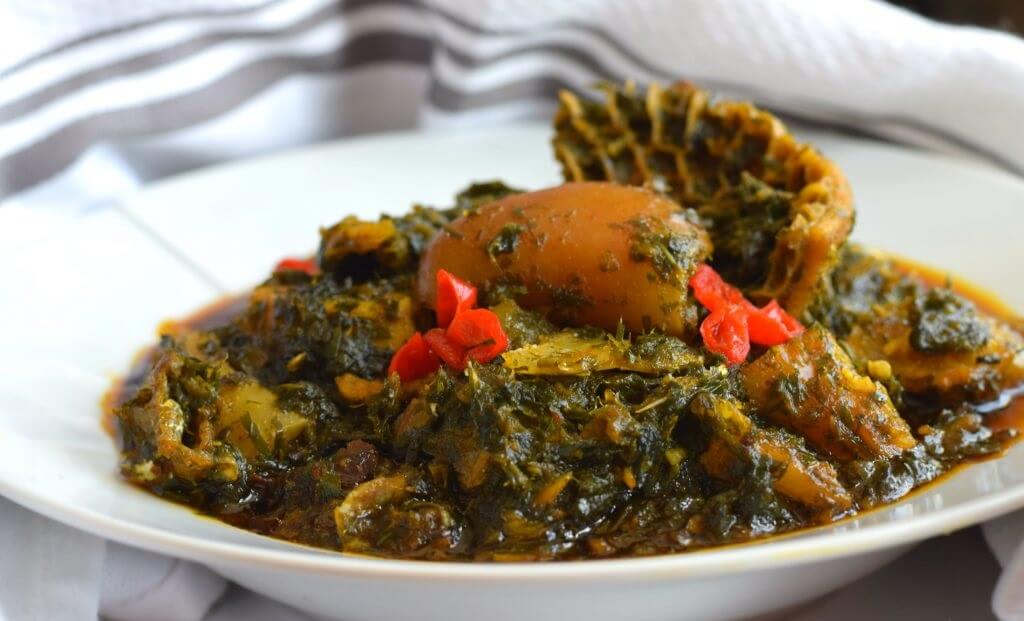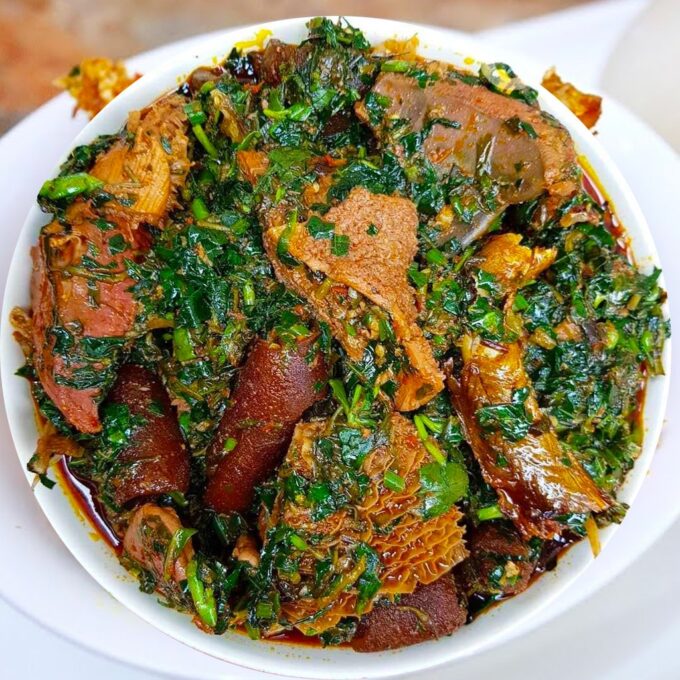Afang soup is a traditional Nigerian soup made with Okazi leaves. It is a native soup to the Efik and Ibibio people in Nigeria and is often served with a variety of staple foods such as yams, plantains, and cassava.
Afang soup is a traditional delicacy that is known for its rich, flavorful taste and nutritional benefits. The soup is made with Afang leaves, also known as Okazi leaves, which are a staple in many Nigerian households. The Afang leaves are a rich source of vitamins and minerals and are believed to have medicinal properties.
This article will guide you through the process of preparing Afang soup step-by-step. From cleaning and cutting the Afang leaves, seasoning the meat or fish, to dicing the onions, you will learn everything you need to know to make a delicious and nutritious bowl of Afang soup.

Ingredients for Afang Soup
- 200 gr beef or assorted meat(cow skin, Shaki (tripe), etc)
- 20 gr Smoked fish
- Stockfish (optional)
- 1 handful of Shelled Periwinkle
- 2 tablespoonful ground crayfish
- 500g Afang Leaves (same as Okazi/Ukazi leaves) – you can use dry or fresh leaves)
- 1kg Water leaves(or lamb lettuce or Spinach as an alternative if you live outside Africa)
- 500 ml Palm oil
- 2 Stock cubes(any one of your choice)
- Fresh pepper (scotch bonnet/atarodo) or ground dried pepper(to taste)
- Salt to taste
READ: How to make peanut: A step by step guide
Preparing ingredients for Afang Soup
Here are step-by-step instructions on how to prepare the ingredients for Afang soup:
Cleaning the Afang leaves: Start by washing the Afang leaves in cold water to remove any dirt. If using dried Afang leaves, soak them in water for about 30 minutes to soften them. Once the leaves are clean, chop them into small pieces and set them aside.
Seasoning the meat or fish: Cut the meat or fish into small pieces and season with salt and pepper. You can also add other seasonings, such as onions, garlic, or ginger if desired.
Dicing the onions: Peel and dice an onion into small pieces.
Grounding the crayfish: If using whole crayfish, grind them in a food processor or mortar and pestle.
Your ingredients are now ready for cooking.
SEE: How to cook catfish pepper soup
Afang Soup Recipe
How to make Afang Soup
Preparing ingredients for Afang Soup
Cleaning the Afang leaves: Start by washing the Afang leaves in cold water to remove any dirt. If using dried Afang leaves, soak them in water for about 30 minutes to soften them. Once the leaves are clean, chop them into small pieces and set them aside.
Seasoning the meat or fish:
Cut the meat or fish into small pieces and season with salt and pepper. You can also add other seasonings, such as onions, garlic, or ginger if desired.
Dicing the onions:
Peel and dice an onion into small pieces.
Grounding the crayfish:
If using whole crayfish, grind them in a food processor or mortar and pestle.
Afang Soup Recipe
Cook the assorted meat and stock fish with chopped onions, one stock cube/seasoning cube, and salt to taste. Cook until tender.
Then clean the dried fish in hot water, remove the bones and add the fish to the pot of cooked meat.
Add the Palm oil, pepper, ground crayfish, and remaining stock cube to the pot.
Mix well, and then add periwinkles (if you are using any).
Cover the pot and leave to boil for about 10 minutes.
After 10 minutes, add the Afang leaves, let them simmer for 3 to 5 minutes, and then add the water leaves.
If using fresh Afang leaves, let it simmer for 3 minutes.
Add salt to taste, simmer for 2 minutes, and your Afang Soup is ready.
Here is a step by step guide on how to make Afang Soup;
Tip: the dry leaves are tougher than the fresh leaves, so try to grind them as fine as you can.
Cook the assorted meat and stock fish with chopped onions, one stock cube/seasoning cube, and salt to taste. Cook until tender.
Then clean the dried fish in hot water, remove the bones and add the fish to the pot of cooked meat.
Add the Palm oil, pepper, ground crayfish, and remaining stock cube to the pot.
Mix well, and then add periwinkles (if you are using any).
Cover the pot and leave to boil for about 10 minutes.
After 10 minutes, add the Afang leaves, let them simmer for 3 to 5 minutes, and then add the water leaves.
If using fresh Afang leaves, let it simmer for 3 minutes.
Tip: it is customary to add water leaves before the Afang leaves, but due to the toughness of the Afang leaves, you can add it first before the water leaves, or whichever way you like. The soup will still taste good.
Add salt to taste, simmer for 2 minutes, and your Afang Soup is ready.
Afang soup is usually served hot with Usi(starch), Eba, Pounded Yam, Fufu, Semolina, Amala, Wheat meal, Tuwo Masara, or any Nigerian Bolus meal.

CHECK THESE OUT:
Nutritional Value
Afang soup is a rich source of several essential vitamins and minerals. The soup’s nutritional value can vary depending on the ingredients used and the preparation method. However, some of the key nutritional benefits of Afang soup include the following:
- Protein: Afang soup is a great protein source, particularly if made with meat or fish. Protein is essential for the growth and repair of body tissues and also helps to maintain strong bones and muscles.
- Vitamin A: Afang leaves are a rich source of vitamin A, which is important for maintaining good vision and a healthy immune system.
- Vitamin C: Afang leaves are also a good source of vitamin C, which is important for maintaining healthy skin, teeth, and gums, as well as helping the body to absorb iron.
- Fiber: Afang leaves are high in fiber which can help to promote good digestion and regular bowel movements.
- Iron: Afang soup is also a good source of iron, which is important for producing red blood cells and transporting oxygen throughout the body.
Afang Soup has high dietary fiber, which helps regulate blood sugar and reduce constipation and weight loss. Okazi leaves have a high quantity of iodine and help to prevent and treat goiter. It boosts immunity and helps improve the body’s natural defenses against diseases.
Waterleaf has also been proven to be useful in treating diabetes as it slows down the conversion of sugar and digestion. In addition, Afang soup is anti-inflammatory and anti-cancer. Traditionalists use Afang leaves as a component in medicines used in treating children suffering from measles and as an antidote for many forms of poisons.
The soup is so rich that it can be passed for a balanced diet. You can eat Afang soup with different types of swallow, including Eba, amala, Semovita, pounded yam, and wheat.
It’s important to note that the soup’s nutritional value can be affected by the use of oil and the addition of salt during preparation.
To explore all the nutritional value of Afang soup, it is recommended to use lean cuts of meat or fish and to use minimal oil and salt during the cooking process.
Other Vegetable Soups that can boost your health
Okra Soup
Okra Soup is a slimy, nutritious soup loaded with proteins and healthy fat. It is made with varieties of vegetables, meats, and seafood.
The mucilage (sliminess) helps to coat the intestines and ensure smooth and regular bowel movements. Okra soup contains a ton of nutrients, such as Vitamin C, that support the immune system. It features beneficial antioxidants such as polyphenols that prevent the adverse effect of harmful molecules called free radicals.
SEE: How to Make Chicken and Chips
Edikang Ikong Soup
Edikang Ikong soup is one of the healthiest Nigerian vegetable soups because of its rich nutritional contents, which include; Protein, Vitamins B1, B2, and E, Fiber, Folic acid, Carbohydrates, Calcium, Iron, Phosphor, Selenium, Potassium. It is with two main vegetables: pumpkin leaves (Ugu) and waterleaf (gbure).
Edikang Ikong is a source of high energy and has been proven to improve bone health, prevent anemia, maintain the health of the nervous system, and maintain healthy skin.
In addition, waterleaf improves blood circulation, boosts immunity, and aids weight loss. The content of fatty acids, vitamin E, magnesium, and zinc have properties to improve and maintain healthy skin in the health benefits of beets for skin care.
(Bitterleaf Soup)
Bitter leaf is one of the most versatile and popular cooking vegetables. It is a leafy green vegetable that is native to parts of Africa. It is highly nutritious and nourishes the body greatly. Bitter Leaf is rich in vitamin A, C, E, B1 and B2.
Bitter leaf soup is known to detoxify the body. Due to its richness in protein, vitamins, and other nutrients, it helps improve the immune system.
Lowers high blood pressure. You will be amazed that the bitterness in bitter leaves has sweet benefits for the body. It might be unpleasant, but it helps to lower high blood pressure.
It relieves stomach ache. Bitter leaf is the best remedy for stomach aches as it helps relieve indigestion and aids proper digestion of food.
SEE: How to make Egg fried Rice: Best Egg Fried Rice Recipes
Afang Soup ingredients variations
Afang soup can be prepared as a versatile dish with various ingredients like meats, fish, and ingredients to suit different tastes and preferences. Here are a few variations of Afang soup that you can try:
Afang soup with groundnuts: Groundnuts, also known as peanuts, can be added to the soup for a nutty flavor and added protein.
Afang soup with Pumpkin leaves: Pumpkin leaves can be used in place of or in addition to Afang leaves to add a different flavor and nutritional value to the soup.
Afang soup with seafood: Some people prefer to add seafood such as shrimp, crab, or snails to the soup for added flavor and protein.
Afang soup with Periwinkle: Periwinkle is also a common addition to Afang soup, it gives a different texture and flavor to the soup.
READ: How to Make Moi Moi
Conclusion
In conclusion, making Afang soup is a simple process that requires minimal effort and time. You can make a delicious and nutritious bowl of Afang soup with the right ingredients and techniques.
Remember to experiment with different variations of the soup and consult a medical professional or a qualified expert in the field before using any traditional medicine, including Afang leaves, for medicinal purposes.

